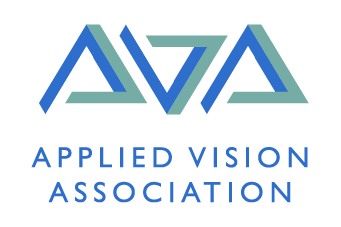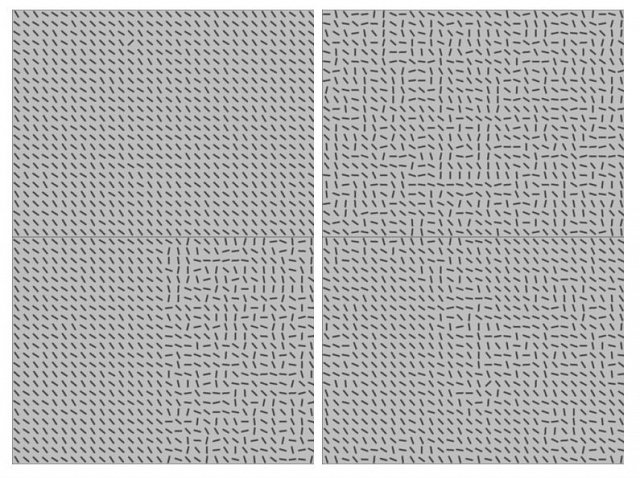

Supervisor: Alasdair Clarke
Imagine you open your bathroom cabinet to look for your toothpaste, there are four shelves, two of which are cluttered and full and 3 of which are nearly empty. Where would be the best place to look? Searching in the two empty shelves is clearly a waste of time. If the toothpaste was there you would easily spot it in the visual periphery. The ideal strategy would be to spend time looking at the two cluttered shelves.
To see if this is what individuals actually do Nowakowska et al (2017) set up a paradigm in which people had to search for a target that was placed amongst distractors. The target was always a line segment tilted 45 degrees to the right. They used 3 types of visual search tasks; easy (image one), hard (image two) and split-half (image three). The optimal strategy in the split half condition would be to spend their time in searching he hard side as it would be easy to see if it was in the easy side.
For this project we added to the paradigm used in the Nowakowska et al (2017) experiment. There findings demonstrate visual search strategies are far from optimal. They used 3 types of visual search tasks; easy (image one), hard (image two) and split-half (image three). This experiment has all of these conditions but we added a jumbled condition (image four) in which the image varies from easy to hard, the target can be in either the hard or easy part of the image. We also made it so the target was tilted 45 degrees to either the left or the right.

Our findings were very similar to Nowakowska et al (2017) for the split half trial, there were large individual differences with some people searching the stimuli very efficiently, while others were below chance. However, for the jumbled condition there was a lot less variation in eye movements and nearly everybody performed above chance. This finding is unexpected, as the optimal search strategy should be easier to implement on the split half trial: the texture boundary between the two halves of the display is salient and the observers simply have to direct their attention to the more heterogeneous half. In comparison, the regions of high variance are less salient in the jumbled condition as they are distributed throughout the stimuli, and the texture boundaries are more gradual.
Skills developed during the placement
During my time as Alasdair Clarke's research assistant I have developed statistical analysis skills. Having previously used only excel and SPSS as data analysis software, learning R was a amazing new skill I have developed. Over the 8-week placement I went through the R for data science (Groleman & Wickham 2017) book and used R to analyse data I had collected over the summer. This new skill will now help me in my studies to analyse data in a more sophisticated way and to write up my dissertation.
Before data collection started I was given the responsibility to pilot the experiments and prepare paper work such as ethics forms, consent forms, participant instructions, advertisements and debrief forms. This was a really useful skill to develop as it taught me the correct procedures that need to be followed in order to run experiments. I was also in charge of participant recruitment, scheduling them in, and then testing the participants.
I was also taught how to use and set up the eye tracker (Eye link) and the software that was used to record the eye movements. This included calibration of the eye trackers, and how to convert raw data files into more data friendly files ready for analysis.
Alasdair Clarke and I are currently working on a paper reporting the findings of our project together. This is really helpful as I am learning how to write papers and about the process of peer review and meeting publisher guidelines.
References
Nowakowska, A., Clarke, A. D F., Hunt, A. R. (2017) Human visual search behaviour is far from ideal. Proceedings of the royal society B. Biological sciences.